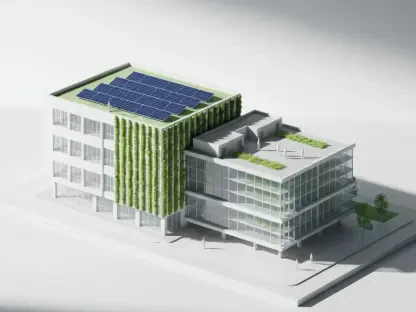In a striking display of market resilience, the commercial real estate lending sector has witnessed a remarkable surge during the second quarter, as detailed in a recent report by CBRE, a leading real estate services firm based in Dallas. This upswing paints a picture of recovery and growing confidence among investors and lenders alike, even as economic uncertainties and policy shifts continue to cast occasional shadows over the landscape. The data reveals a robust 45% year-over-year increase in the CBRE Lending Momentum Index, a key metric tracking the pace of commercial loan closings originated by CBRE. Despite a minor 6% dip from the prior quarter due to early-period challenges, the index rebounded impressively by June, signaling a strong trajectory. This resurgence highlights not only the adaptability of the market but also the determination of stakeholders to navigate complex conditions, setting the stage for a deeper exploration of the forces driving this momentum and the diverse players contributing to the sector’s vitality.
Robust Growth and Market Recovery
The commercial real estate lending market has shown significant strength, with the CBRE Lending Momentum Index reaching a value of 275 in June, far surpassing the five-year pre-pandemic average of 229. This achievement underscores a powerful recovery from earlier setbacks in the quarter, when policy uncertainties and tariff announcements temporarily disrupted borrowing conditions in April and May. The sharp rebound by the end of the period reflects a renewed sense of optimism among market participants, who appear increasingly willing to engage despite lingering economic questions. A key factor in this growth is the sustained interest in high-demand asset classes like industrial and multifamily properties, which continue to attract substantial capital. These sectors, often priced below replacement cost, have become focal points for investors seeking stable returns, further fueling the lending surge. This dynamic illustrates how targeted demand can bolster overall market confidence, even in the face of broader challenges.
Beyond the headline numbers, the recovery is also evident in the stabilization of credit conditions, which have adjusted to more balanced levels after initial volatility. The ability of the market to weather early-quarter turbulence points to a maturing resilience, supported by a strong transaction pipeline that promises sustained activity. Notably, the capital markets have demonstrated flexibility, with lenders and borrowers alike adapting to shifting risk premiums influenced by external factors. This adaptability is critical, as it allows the sector to maintain momentum despite headwinds. The focus on asset classes with strong fundamentals has further reinforced this trend, ensuring that capital flows into areas with proven demand. As a result, the commercial lending environment appears poised for continued growth, provided that external pressures do not escalate. This evolving stability offers a glimpse into the sector’s potential for long-term strength, driven by strategic investments and a commitment to navigating uncertainty.
Diverse Lender Participation Fuels Expansion
A closer look at the lending landscape reveals a diverse array of participants driving the sector’s expansion, with alternative lenders such as debt funds and mortgage REITs taking a leading role. These entities captured a 34% market share in non-agency loan closings, up from 32% in the prior year, propelled by an impressive 89% quarter-over-quarter increase in lending volumes from debt funds alone. Meanwhile, banks, though experiencing a reduced market share of 24% compared to 29% previously, still achieved a 17% growth in origination volume, indicating a cautious yet steady reentry into the market. Life companies maintained a 23% share, showing slight improvement from the last quarter, while CMBS lenders saw a dramatic rise to 19% from just 9% a year ago, thanks to a tripling of lending volumes through active private-label issuance. This broad participation underscores the depth of capital available, painting a picture of a market supported by varied sources of funding.
Additionally, government agency lending for multifamily assets has emerged as a powerhouse, soaring to $28.9 billion in the second quarter, a 31% increase from the prior quarter and 43% year-over-year. This growth is partly attributed to a drop in agency mortgage rates to 5.7%, down 13 basis points from the previous period, making financing more attractive for borrowers. The tightening of multifamily loan spreads by 22 basis points to 150 further highlights the competitive pricing in this segment, contrasting with broader commercial mortgage spreads that widened to an average of 193 basis points. This disparity reflects the unique appeal of multifamily assets amid strong investor interest. The active involvement of various lender types, from alternative funds to government agencies, demonstrates a robust ecosystem where different players contribute to overall growth. Such diversity not only mitigates risks but also ensures that capital remains accessible across multiple channels, fortifying the market against potential disruptions.
Evolving Dynamics and Future Outlook
Shifting dynamics in loan pricing and investor preferences are shaping the commercial lending environment in notable ways. While overall commercial mortgage spreads have widened, the tightening in the multifamily sector signals a targeted confidence in assets perceived as low-risk and high-return. Industrial properties also continue to draw significant attention, as investors prioritize sectors with strong fundamentals over more speculative opportunities. This selective approach suggests a maturing market where capital allocation is driven by data and long-term value rather than short-term gains. The resilience of these asset classes, even as broader economic questions persist, points to a strategic focus that could sustain lending activity in the coming quarters. Market participants seem to be balancing caution with opportunity, ensuring that investments align with proven demand trends.
Reflecting on the second quarter, the commercial real estate lending sector demonstrated remarkable adaptability, overcoming early challenges to achieve significant growth. The stabilization of credit conditions and the surge in transaction volumes across lender categories highlighted a market on the mend. Looking ahead, stakeholders should prioritize monitoring policy developments and economic indicators to anticipate potential disruptions. Strengthening partnerships between diverse lenders and focusing on high-demand asset classes like multifamily and industrial properties could further solidify this upward trajectory. Additionally, leveraging competitive pricing strategies, as seen in agency lending, may attract more capital into the market. As the sector moves forward, maintaining this balance of caution and confidence will be key to navigating uncertainties while capitalizing on emerging opportunities for sustained expansion.









